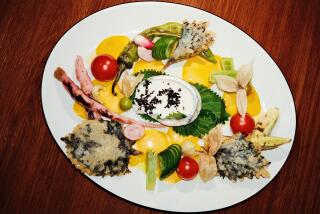Sit and Satay Awhile
- Share via
The Blue Orchid Satay House may sound like it’s somewhere in the rain forests of Indonesia, but it’s stuck between a lawn mower repair shop and an out-of-business nail salon on an ordinary commercial street in Arcadia.
Still, once you enter this simple, informal place where the owner and his small daughter greet you at the door, the rich aromas of satay, nasi goreng and pecis (spiced meatballs) conjure up the markets in central Java’s countryside. And that’s how you know that you’ve come to the right rumah makan, or eating place.
Maps of Indonesia and Java decorate the modest establishment’s walls, and tables are covered in brightly patterned batik. Like similar little restaurants in Indonesia--or in Amsterdam, for that matter--the Blue Orchid is family run. When the grandmother isn’t helping her daughter cook, she sits in the hallway between the kitchen and dining area watching soap operas on TV. The tiny granddaughter, dressed up in traditional batik, scribbles in her coloring book. Her mother and a cousin cook, take orders and serve; father tends the cash register and, out in the back alley, grandfather chats with his cronies.
The specialty here, of course, is satay, a staple item whenever Indonesians gather for a backyard barbecue. Meats--a choice of lamb, chicken, beef or pork--are marinated in kecap, a sweet Indonesian soy sauce, threaded onto a bamboo skewer and grilled. The meat is charred on the outside, tender within, delicious dipped in more kecap laced with bits of raw garlic. My favorite is the lamb, which has been marinated a little longer than the other meats, to take on a complex sweetness.
The Blue Orchid’s appetizers and desserts are displayed in a glass case that sits on the counter. My sister, who, like me, is half Indonesian, has a fondness for the rolled rice bars called lemper, sticky rice steamed in coconut milk and stuffed with shredded turmeric-spiced chicken. Lempers are hard to find in other Indonesian restaurants in Los Angeles, and my sister would never speak to me again if she found out I went to the Blue Orchid without bringing a few home for her.
Lumpia, which are more or less Indonesian spring rolls, are disappointing--soggy and not crisp enough. But the ikan teri--salt fish fritters sold in takeout baggies at the counter--make a tasty appetizer too.
For those unfamiliar with Indonesian cuisine, it may help to know that nasi is rice, bakmi (the “k” is silent) are noodles, and goreng means anything fried. Your waiter will offer advice or you can eye neighboring tables and ask for whatever looks good. Before you order, check the daily specials posted above the window to the kitchen.
Even my Indonesian mother couldn’t identify a few of the dishes, yet she happened to order the best of the specials that night and once her nasi kuning was served, she recognized the dish immediately by its bright yellow rice. Normally made only for festive occasions, the base of nasi kuning is rice boiled in coconut milk and flavored with lemon grass and kaffir lime. Turmeric gives it its radiant color and unique flavor.
Traditionally the flat bed of rice is garnished with eight accompaniments, which are meant to be eaten separately, not mixed into the rice. These include dendeng terik, shredded beef marinated in sambal; ayam panggang, fried chicken in nutmeg batter; acar, pickled vegetables; and bawang goreng, fried onions with sliced potatoes glazed in kecap. The dish is crowned with a pale pink shrimp cracker.
Other nasi dishes are garnished with a similar array of items but are made with white rice instead of yellow. Not all of them are as good as nasi kuning. Nasi langgi’s curried chicken is a little dry and its mild, almost bland, no match for intricately spiced Indian curries. The beef served on the side of nasi urap, another special of the day, seems dried out too, but its coconut milk and Javanese brown sugar sauce is quite nice. Kepiting lemburi, or soft-shelled crab, doesn’t have as much flavor as I would like either.
Indonesian food can be spicy, especially if you add spoonfuls of sambal to your dishes. To cool the palate, get one of the colorful traditional shaved ice drinks served in tall fountain glasses. Ice teler has chunks of avocado and snowy young coconut meat stirred together with the shaved ice, a swirl of coconut milk and sweet green syrup, and slippery jackfruit colored pink, yellow and green. The rambutan features rose syrup and lychee settled at the bottom of the glass. But ice cendol, sweetened with green mung bean gelatin drops, brown sugar and coconut milk, is the most popular shaved ice drink among Indonesians. Ask for enough straws and long fountain spoons so that everyone at the table can have a taste.
At dessert, the restaurant switches from Indonesian to Dutch tastes as customers leave with a bag of stroepwafels, iron-flattened cookies filled with caramel, and spekkoek, a dense, striated cake of cinnamon, cardamom and cloves, for their coffee at home.
(BEGIN TEXT OF INFOBOX / INFOGRAPHIC)
Where to Go
Blue Orchid Satay House, 124 E. Live Oak Ave., Arcadia; (818) 574-8871. Tuesday-Sunday, 11:30 a.m.-8 p.m. Lot Parking. No beer or wine. No credit cards. Dinner for two, $10 to $15.
What to Get
Lempers, nasi kuning, nasi rames, satays, ice cendol.
More to Read
Eat your way across L.A.
Get our weekly Tasting Notes newsletter for reviews, news and more.
You may occasionally receive promotional content from the Los Angeles Times.










